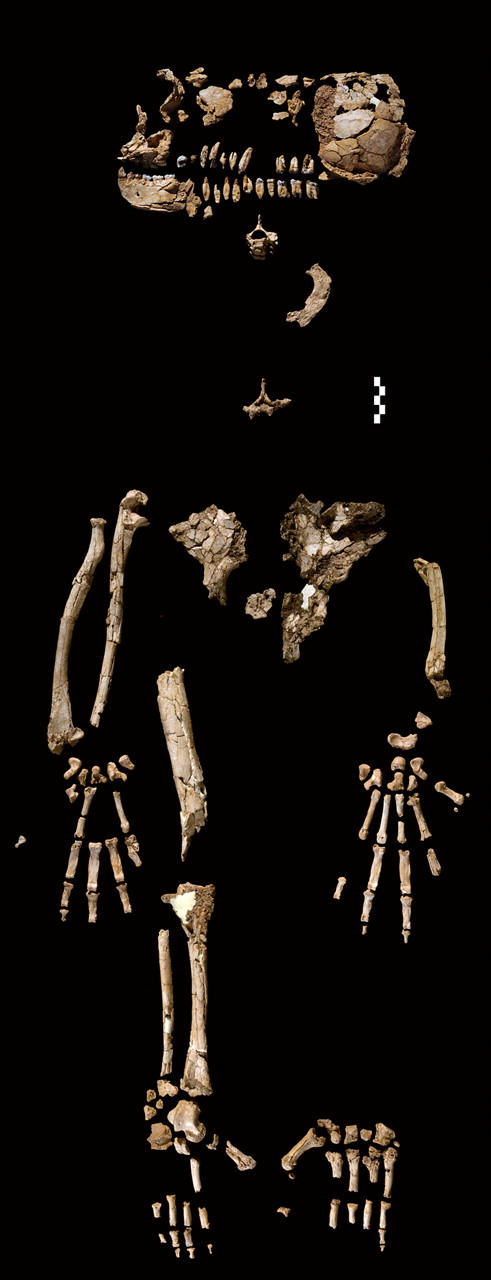Image source: By T. Michael Keesey – Zanclean skullUploaded by FunkMonk, CC BY 2.0, https://commons.wikimedia.org/w/index.php?curid=8541387
The hominid known as “Ardi” (a specimen of Ardipithecus ramidus) was discovered in 1994, at a site near Ethiopia’s Awash River. Once excavated, it turned out that this was – for its age – a remarkably complete specimen: 125 fossilised bones, comprising most of the skull, teeth, hands & feet, pelvis, and the lower sections of the arms & legs. This fossil treasure – and a wealth of other information from the rock layers in which it was found and from the remains of other A.ramidus individusals – provided a huge amount of information to an international team of scientists, who published a total of 11 open-access papers about this hominin species and its environment, in 2009. (It sounds as if extracting Ardi’s remains was a considerable challenge, given that they were described as “so soft that they would crumble when touched”, and required very delicate handling. It took several years to clean and stabilise them for subsequent analysis.)

Image: The ARA-VP-6/500 skeleton. This is a composite photograph to show the approximate placement of elements recovered. Some pieces found separately in the excavation are rejoined here. Intermediate and terminal phalanges are only provisionally allocated to position and side. From White, Asfaw, Beyene, Haile-Selassie, et al., 2009)
Analysis of Ardi’s skeleton, and the remains of the other individuals, let scientsts draw a number of conclusions about this early hominid: its gender (data from Ardi’s teeth suggest this was a female); the species’ diet (omnivorous); social behaviour (its limited sexual dimorphism suggests a social structure akin to that of chimpanzees); and locomotion (from an analysis of the ‘postcranial’ skeleton ie everything from the neck down). Here, White & his colleagues inferred that ramidus was able to move bipedally on land, albeit on a foot that could also grasp branches, and clamber about in trees using the palms of its hands & soles of its feet. Ardi’s bones show a number of adaptions to these forms of locomotion – and none for the knuckle-walking seen in modern great apes. This led them to comment that
Another strong inference is that [members of our lineage] have never knuckle-walked
which in turn implies that the evolution of knuckle-walking in chimpanzees occurred after chimps and hominins diverged from their last common ancestor, somewhere between 5 and 6 million years ago.
And that leads to two further points.
The first is that an additional analysis of Ardi’s pelvis, published in 2018, suggests that she had an efficient, fairly human-like mode of walking, going by the shape of her pelvis. This, while also being a pretty good arboreal climber – and that’s a combination of features not seen in later hominins (including both the 3.2 million-years-old “Lucy” and ourselves). And even more recently, the examination of an ankle bone from a different member of A.ramidus found that this individual could move even more efficiently than Ardi, with “an ankle that better supported its legs and [body]”. This change in the ankle bones meant that the individual could use its big toe to push off as it strode along. (However, it still had the same grasping toes and flat feet.) So we have a snapshot of the sort of variation within a species that gives natural selection something to work on.
Which brings me to point #2, and a quote from Friday’s Science News bulletin.
The discoveries at Gona strengthen the argument that Ardipithecus represents the best available model for what the last common ancestor of humans and chimps looked like, Simpson’s group contends (SN: 1/16/10, p. 22). Some researchers regard living chimpanzees as reasonable examples of a last common ancestor. Yet Ardi and her Gona cohorts, among their many nonchimplike characteristics, display no signs of knuckle-walking or being able to swing by their arms through trees. So evolutionary predecessors of Ardi’s kind were unlikely to look much like chimps, Simpson says.
And indeed, why on earth would we expect chimps to be particularly close to that last common ancestor (LCA) of 5-6 million years ago. After all, the chimanzee lineage – just like our own – has been on its own evolutionary trajectory ever since they diverged. (Richard Dawkins talks about this in The Ancestor’s Tale, using a thought experiment to point out that – if we could walk back down our own timeline – we’d encounter ancestors looing less & less like ourselves until we reached the LCA. And then, if we then walked up the chimp timeline, the reverse would happen: we’d move from less-&-less to more-&-more chimp-like as we approached the present.)
In other words, Ardi may be close(ish) to the LCA of chimps and hominins, and her own evolutionary ancestors would not have looked much like either of her many-times-grandspecies.
